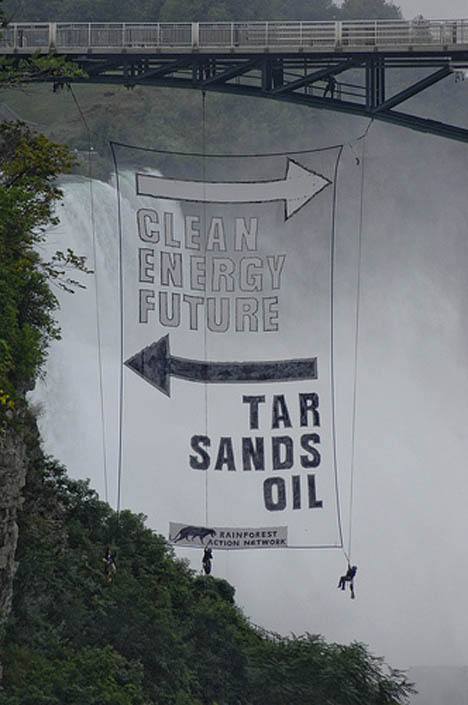Three Islanders holding a banner dangled over Niagara Falls Tuesday as a way to protest Canada’s efforts to extract oil from the tar sands of its boreal forests, what one protester called “the most environmentally destructive project on Earth.”
The protest was staged to highlight the increasingly controversial extraction process just as Canadian Prime Minister Stephen Harper and President Barack Obama began a two-day U.S.-Canadian summit where they planned to address a number of issues, from the war in Afghanistan to trade between the two countries.
Considerable attention has been focused on the tar sands controversy in Canada, but it’s received little attention in the United States, said Logan Price, one of the protesters.
“We knew clean energy would be a focus of their meetings,” Price said in a telephone call from New York. “But the tar sands … are sort of the skeleton in the closet for Canada.
“It’s becoming the most environmentally destructive project on Earth and making Canada one of the world’s worst carbon emitters,” he added.
Price, Nick Simmons and Aleythea Dolstad — all of whom were raised on Vashon — rappelled from the observation deck on the U.S. side of the falls before dawn on Monday, unfurling a banner 70 feet by 40 feet. The top of the banner was attached to the catwalk beneath the observation deck; Price, Simmons and Dolstad, attached to ropes and cables, used their weight to anchor the bottom of the banner in place. Logan said his anchor point was 200 feet above ground.
The three Islanders, who were among those who used direct action last winter to protest Glacier Northwest’s efforts to build a pier on Maury Island, hung from the catwalk for about four or five hours, Price said.
When high winds began to make it more difficult, they pulled themselves back up to the catwalk, where they were arrested for criminal trespass and reckless endangerment, both misdemeanors, he said.
All three pleaded not guilty in Niagara Falls City Court on Thursday and were released on $500 bail, according to the Buffalo News.
“There was a lot of adrenaline,” Price said of the action. “We had to put a lot of faith in our safety system and our rope system.”
Price said he used his cell phone to Twitter during the action, Tweets that got picked up by hundreds and that lit up the blogosphere. He called the action a success — measured by the fact that the effort garnered attention and that no one was hurt.
“Technically, everything went well,” he added.
The tar sands, called the oil sands by some in the Canadian press, comprise a large expanse of northwestern Alberta — a remote area of boreal forests and peat bogs where bitumen, a hydrocarbon paste, has been commercially extracted from open-pit mines and refined into petroleum products since 1967. The extraction rate has picked up considerably in recent years, leading to a booming economy in Alberta and growing concern about the ecological impact.
The extraction takes a huge toll on the northern Canadian landscape. But also of great concern is the amount of energy the refining process takes. Price said it takes three barrels of natural gas to produce one barrel of oil from Canada’s tar sands. According to a report just issued by Greenpeace, Alberta’s oil sands produce more greenhouse gas-emissions than some European countries and will produce more than all of the world’s volcanoes in 11 years if the pace of development continues.
With the U.S.-Canadian summit underway, other groups are also trying to focus attention on the impact Alberta’s oil sand production is having on the environment. On Tuesday, according to MSNBC, 20 Greenpeace activists shut down a massive Shell oil sands mine in northwest Alberta by chaining themselves to giant earth-moving equipment.
Price said he saw his efforts at Niagara Falls as an extension of the work he’s been doing over the last several years, which has included post-Katrina relief efforts in New Orleans, hurricane-related relief efforts in Cuba and protests against Glacier. But dangling over Niagara was especially exhilarating, he said.
“It was pretty momentous in our lives,” Price said.



